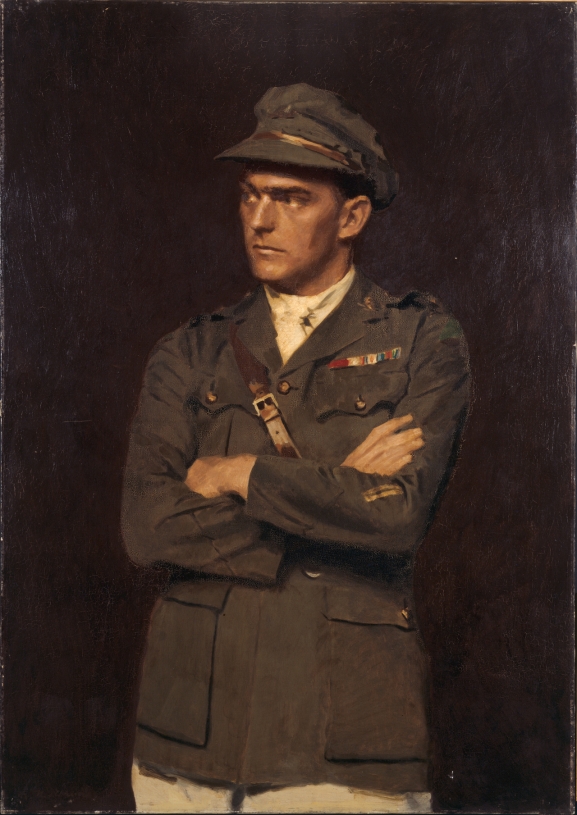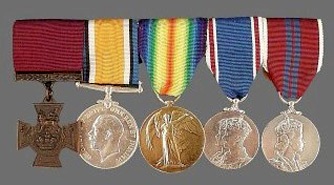STORKEY, Percy Valentine
Lieutenant, 19th Battalion, Australian Infantry Force, France, 7 April 1918
KNOWN AWARDS
Victoria Cross
British War Medal
Victory Medal
King George VI Coronation Medal (1937)
Queen Elizabeth II Coronation Medal
NOTES
Born 9 September 1893, Napier, New Zealand.
Died 3 October 1969, Teddington, London, England
Place of burial or cremation: Cremated at South-West Middlesex Crematorium, Hanworth.
BIOGRAPHICAL
Early Life
Percy Valentine STORKEY was the son of English-born Samuel James STORKEY, printer, and his wife Sarah Edith, née Dean, from Auckland. Educated at Napier Boys’ Grammar School and Victoria College, Wellington, he reached Sydney in 1911 where he worked as a clerk for the Orient Steamship Co. and then for the Blackfriars Teachers’ College. In 1912 he joined the administrative staff of the University of Sydney and next year enrolled as a law student. Having had five years’ service with the Wellington Infantry, he enlisted in the Australian Imperial Force as a private on 10 May 1915 and was commissioned second lieutenant in September.
Service in WWI
A 'well-knit figure [5 ft 7½ ins (171 cm) tall] with dark hair and eyes … a laughing face and dare-devil, happy-go-lucky ways', he embarked for England in December 1915 with reinforcements for the 19th Battalion. On 14 November 1916 he joined his unit in France; five days later, while the 19th was attacking Gird Trenches north of Flers, he was wounded. Promoted lieutenant in January 1917, he was again wounded on 10 October during the 3rd battle of Ypres. On 7 April 1918 the 5th Brigade, of which the 19th Battalion formed part, was assigned to clear the area north of Hangard Wood, near Villers-Bretonneux. Intelligence had inaccurately reported that the wood was 'lightly held'. The attacking company of the 19th, whose men were tired, lay down at the starting line at dawn. STORKEY, who was second-in-command, fell asleep and his company left without him; it had advanced about eighty yards (73 m) when he woke. He caught up with his men only to go through heavy machine-gun fire which had hit 25 per cent of them even before the company's leading groups reached the edge of the wood. Captain WALLACH, the company commander, was shot in both knees and Storkey took over, leading six men through head-high saplings to get behind the German machine-gun force. Together with another officer and four men, they broke into a clearing behind several trenches from where the Germans were firing at the rest of STORKEY's company. One of the Australians yelled when he saw the enemy, some of whom looked around. For both sides it was attack or perish. Storkey instantly headed the charge, engaging the nearest Germans before they had fully reacted. His party killed or wounded thirty of them and the survivors, comprising over fifty men, surrendered. STORKEY's confident and determined leadership had given the impression that he led a larger force than the handful visible to the Germans. He was awarded the Victoria Cross. He was later again wounded in action and in May promoted captain; he returned to Australia in November and his A.I.F. appointment ended in January 1919.
Later Life
Resuming his studies at the university, he graduated LLB in 1921 (while holding an appointment as associate to Justice Sir Charles Wade). Admitted to the Bar on 8 June, STORKEY practised in common law before being appointed to the New South Wales Department of Justice as crown prosecutor for the south-western circuit. He held this post for eighteen years. On 15 April 1922 he married an English born divorcee Minnie Mary GORDON, née Burnett, at St Stephen’s Presbyterian Church, Sydney; they made their home at Vaucluse. At the Bar STORKEY was ‘practical and realistic’, his outlook being tempered by humour and compassion. In May 1939 he became district court judge and chairman of quarter sessions in the northern district of New South Wales. There he became an identity, making many friends and being recognized for his quick assessment of character and for his sound common sense. He was ‘good looking, with dark hair and a shortish, well-built figure, always well dressed’. In 1955 he retired and went to England with his wife to live at Teddington, Middlesex, where he died without issue on 3 October 1969. His wife survived him. STORKEY bequeathed his Victoria Cross to his old school at Napier. His portrait by Max MELDRUM hangs in the Archives Building, Wellington.



THE PRO PATRIA PROJECT
